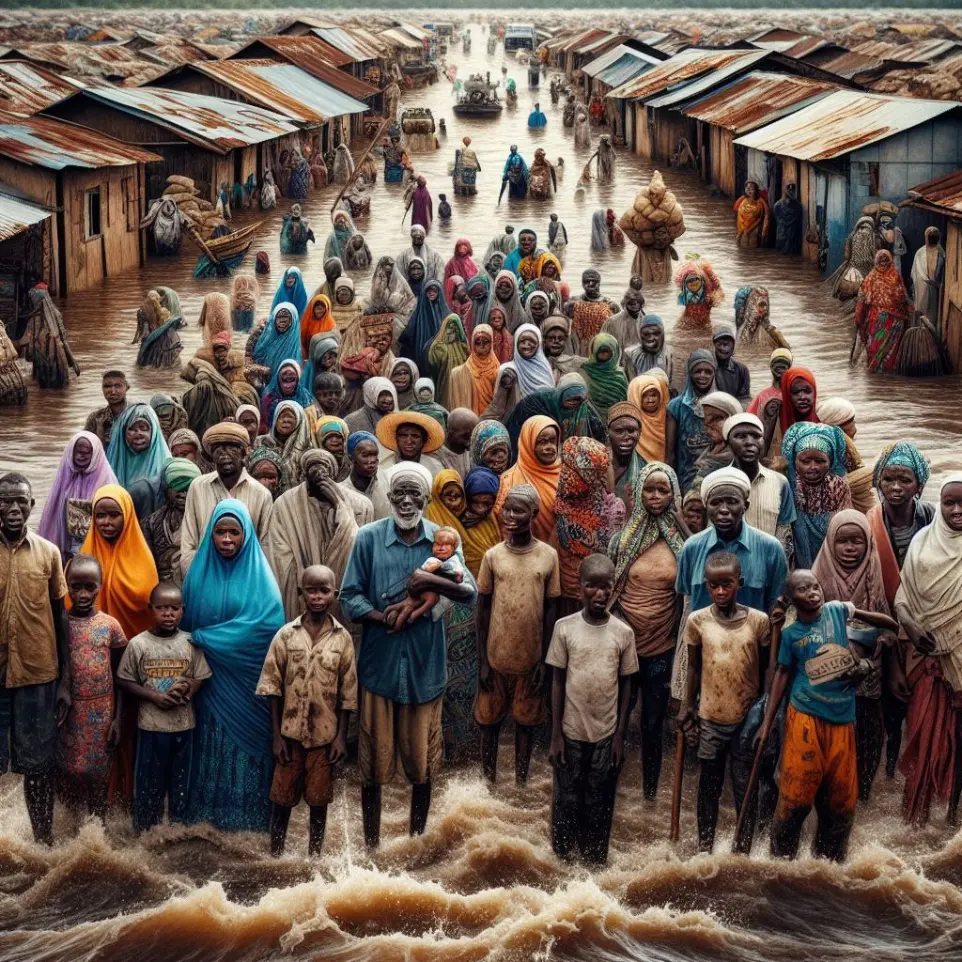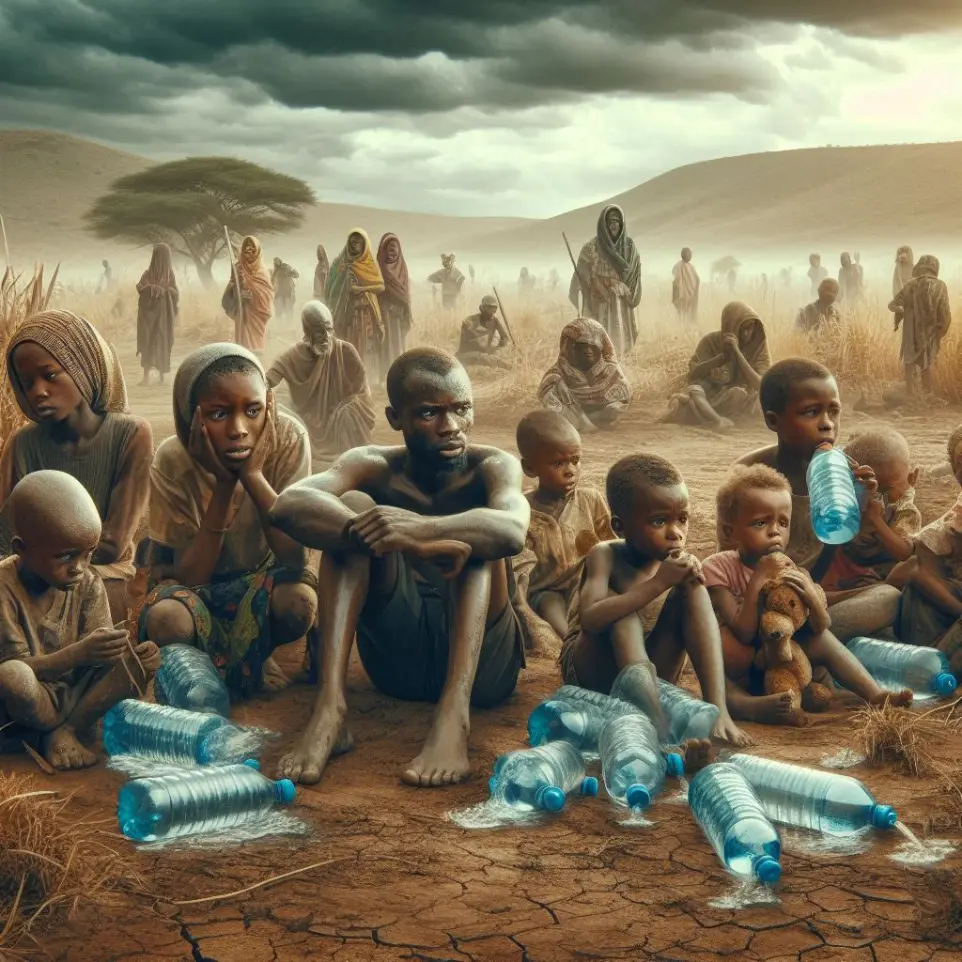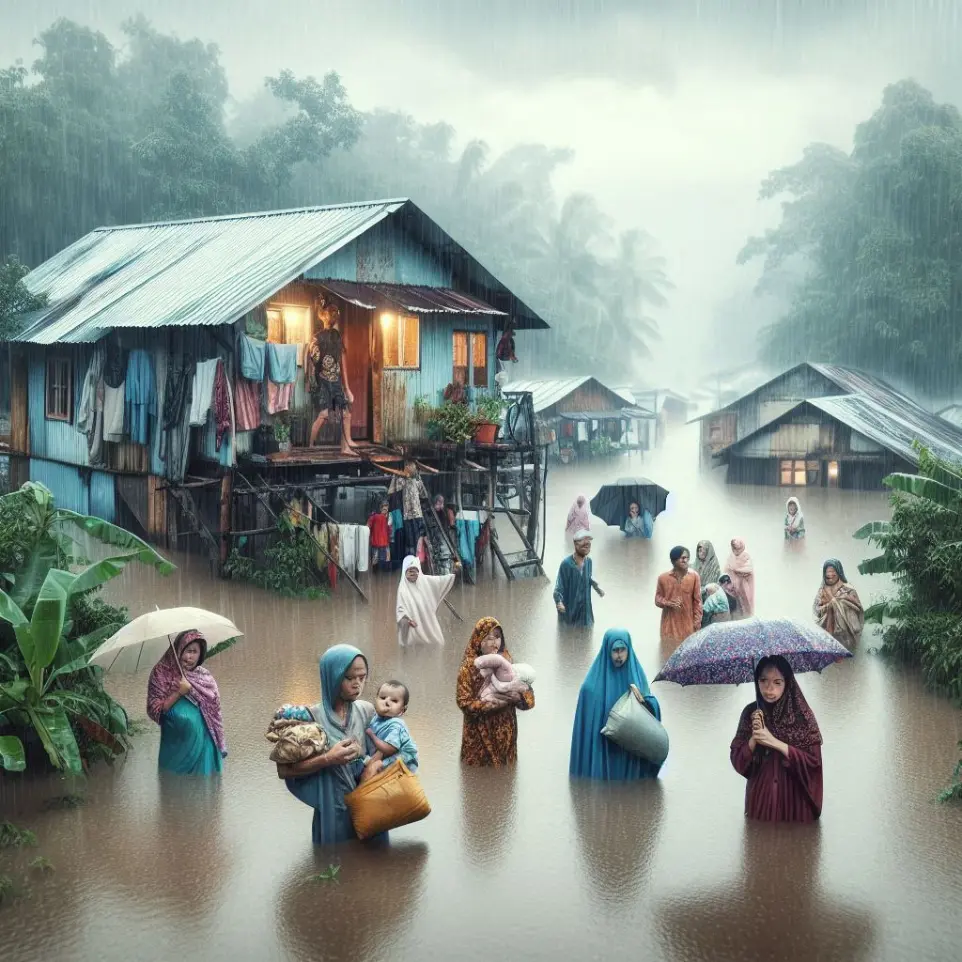



Climate Change and Forced Migration: A New Kind of Refugee
In our article "Climate Change and Forced Migration: A New Kind of Refugee" we will explore the impact of climate change on forced migration, a crucial topic today. Get ready to delve into an in-depth analysis of environmental rights and their impact on the lives of millions of people around the world. Read on to discover how climate change is shaping a new reality for refugees!
Introduction
Climate change is a phenomenon that has generated various consequences at a global level, one of which is forced migration. This situation occurs when environmental conditions push people to leave their homes in search of safety and opportunities elsewhere. In this context, it is essential to understand the relationship between climate change and forced migration, as well as its impact on affected populations.
Climate change refers to significant and long-term modifications in the Earth's climate patterns, generally attributed to human activity. These changes include increased temperatures, extreme weather events, such as hurricanes and floods, and the alteration of ecosystems.
On the other hand, forced migration is the displacement of people from their places of origin due to the existence of inhospitable or dangerous conditions, such as environmental degradation, scarcity of natural resources, and natural disasters caused by climate change.
Forced migration represents a challenge to human rights as people are forced to abandon their homes, families and ways of life, facing precarious conditions and often discrimination at destinations.
Climate change directly impacts natural resources and the ability of communities to sustain themselves. Soil degradation, water scarcity, crop failure and desertification are consequences of climate change that affect people's livelihoods in different regions of the world. As a result, forced migration increases as people seek safer and more sustainable living conditions elsewhere.
The relationship between climate change and forced migration is neither linear nor direct, as various social, economic and political factors intervene. However, it is undeniable that climate change acts as a catalyst for forced migration, exacerbating tensions and pressures on vulnerable populations.
It is important to address this relationship in a comprehensive manner, considering not only environmental aspects, but also human rights, social justice and international cooperation.
The impact of climate change on forced migration is manifested in the vulnerability of displaced persons, the loss of cultural roots, exposure to violence and the difficulty in accessing basic services in destination places. In addition, forced migration can generate tensions and conflicts in host communities, especially when there are no adequate policies and mechanisms to manage this situation.
In this regard, it is essential that governments and the international community recognize the impact of climate change on forced migration and establish adaptation, mitigation and protection strategies for those affected. It is also necessary to promote cooperation and solidarity between countries to address this challenge effectively and in a manner that respects human rights.
Climate change and forced migration are closely related, and their impact represents a significant challenge for the protection of human rights at a global level. It is essential to adopt a comprehensive approach that recognizes the complexity of this problem and promotes concrete actions to guarantee the dignity and security of those affected.
The impact of climate change on forced migration is currently a matter of growing concern globally. According to the United Nations, it is estimated that around 22.5 million people were forced to move due to natural disasters in 2019, and this number is projected to increase considerably in the coming years.
Forced migration as a result of climate change disproportionately affects vulnerable communities, especially in regions prone to extreme weather events, such as floods, droughts and storms. These communities, which often directly depend on natural resources for their livelihoods, are forced to leave their homes due to environmental degradation and the loss of sustainable livelihoods.
In addition, climate change can also exacerbate existing conflicts and increase pressure on natural resources, which in turn can trigger mass population displacement. This phenomenon poses significant challenges for both host countries and communities of origin, and underscores the urgent need to address the impact of climate change on human rights and forced migration.
The Impact of Climate Change on Forced Migration
Climate change has had a significant impact on forced migration of vulnerable communities around the world. These communities, which often rely heavily on natural resources for their livelihoods, are affected by extreme weather events such as floods, droughts, and more intense storms. As a result, they are forced to leave their homes in search of safer and more sustainable living conditions.
This displacement brings with it a range of challenges, including the loss of agricultural land, disruption of traditional livelihoods, and exposure to situations of extreme vulnerability. Furthermore, indigenous communities and rural populations are particularly susceptible to these impacts, highlighting the need to address displacement in a comprehensive manner and with a human rights-centered approach.
Forced migration as a result of climate change poses complex challenges that require urgent action at the global level, in order to protect the fundamental rights of displaced people and address the underlying causes of this phenomenon.
Forced migration due to climate change is the result of a combination of environmental, social and economic factors. Environmental factors include land degradation, water scarcity, rising sea levels and the frequency of extreme weather events. These environmental impacts directly affect the ability of communities to sustain and thrive in their traditional environments.
In addition, social and economic factors, such as poverty, lack of employment opportunities and food insecurity, also influence people's decision to migrate. The complex interaction of these factors makes climate-driven forced migration a multidimensional phenomenon that requires comprehensive and coordinated responses at local, national and international levels.
Understanding these factors is critical to effectively addressing the needs of displaced people and mitigating the impacts of climate change on forced migration.
Statistics show that climate change is having a significant impact on forced migration around the world. According to the International Organization for Migration (IOM), it is estimated that by 2050, between 25 million and 1 billion people could be displaced due to the effects of climate change.
In addition, there are numerous case studies that illustrate the concrete impacts of climate change on forced migration. For example, in Bangladesh, rising sea levels have forced thousands of people to leave their homes in coastal areas. In Africa, desertification and water scarcity have led to the displacement of entire communities in search of more sustainable living conditions.
These cases underline the urgent need to address the link between climate change and forced migration, as well as to develop strategies to protect displaced people and address the underlying causes of this phenomenon.
Forced migration due to climate change presents significant differences compared to other types of refugees. While traditional refugees flee armed conflict or political persecution, climate migrants are forced to leave their homes due to natural disasters, resource scarcity, or environmental degradation. This distinction is crucial, as climate refugees are not protected by the same international laws that traditional refugees are protected by, creating legal loopholes and additional challenges to their protection and assistance.
Furthermore, unlike refugees seeking asylum in other countries, many climate migrants are internally displaced within their own countries, further complicating their legal status and access to humanitarian aid. This lack of legal recognition and international protection poses unique challenges for the global community in terms of policy, legislation, and international cooperation to address this growing humanitarian crisis.
It is important to understand that while there are similarities in terms of the need for protection and humanitarian assistance, the context and underlying causes of climate-forced migration require specific approaches tailored to these unique circumstances. The comparison with other types of refugees highlights the urgent need to develop international legal frameworks and policies that recognise and address the complexities of forced migration caused by the impact of climate change on human rights.
Human Rights and Forced Migration
Currently, there is no specific international legal framework that comprehensively addresses forced migration caused by climate change. However, there are legal instruments that can be applied to this situation, such as the 1951 Geneva Convention on the Status of Refugees and its 1967 Protocol, which establish the protection of people fleeing their country due to "well-founded fears of persecution" on the grounds of race, religion, nationality, membership of a particular social group or political opinion.
In addition, the 2015 Paris Agreement recognizes the importance of taking measures to strengthen the global response to migration caused by climate change, although it does not establish binding provisions in this regard.
In the absence of specific regulations, various countries and international organizations are promoting the inclusion of climate migration in the existing legal framework, in order to provide protection to people who are forced to move due to environmental impacts.
Countries hosting migrants forced by climate change face the challenge of ensuring protection and assistance to these people, recognizing their status as climate refugees. Although the Geneva Convention does not contemplate specific protection for this type of displacement, host countries have the responsibility to welcome these people and guarantee them decent living conditions, respecting their fundamental human rights.
In addition, it is essential that host countries work in collaboration with international organizations, civil society and other relevant actors to develop policies and strategies that effectively address forced migration caused by climate change. International cooperation is essential to address this challenge in a comprehensive and fair manner.
It is also crucial that host countries promote public awareness about forced migration due to climate change, fostering solidarity and empathy towards those affected and combating discrimination and xenophobia.
Protection and assistance to climate refugees is a crucial aspect of the global human rights agenda. Countries and international organizations need to develop specific mechanisms to ensure the protection of these people, providing them with humanitarian assistance, access to basic services, and opportunities for integration into host communities.
In addition, it is essential that adaptation and resilience programs be implemented in communities vulnerable to climate change, in order to prevent forced migration and protect the human rights of people at risk.
Protecting climate refugees also involves addressing the underlying causes of climate change and working to mitigate its impacts, promoting sustainable environmental policies at national and international levels.
Forced migration caused by climate change poses significant legal and humanitarian challenges at a global level. First, existing legal frameworks related to refugees and migration are not adapted to adequately address this new form of human displacement. The 1951 Convention relating to the Status of Refugees and its 1967 Protocol do not include specific provisions on the status of climate refugees, leaving these people in a legally ambiguous situation and without adequate protection.
Moreover, at the humanitarian level, forced migration related to climate change poses logistical and resource challenges for host countries and humanitarian organizations. The scale and unpredictable nature of this phenomenon make it difficult to plan and deliver humanitarian assistance effectively. The lack of legal recognition of climate refugees can also hinder access to aid and protection for those forced to leave their homes due to natural disasters or environmental degradation.
In this context, the international community faces the challenge of developing legal frameworks and humanitarian mechanisms that recognize and address forced migration caused by climate change, ensuring adequate protection and assistance for those affected. This requires a collaborative and proactive approach involving governments, intergovernmental organizations, NGOs and civil society in the search for sustainable and human rights-respecting solutions to this growing global problem.
Actions and Solutions
Climate change adaptation and mitigation policies are essential to address the impact of climate change on forced migration. Reducing greenhouse gas emissions, transitioning to renewable energy sources and implementing sustainable practices are key measures to mitigate climate change. It is also crucial to develop adaptation policies that strengthen the resilience of communities to climate impacts, thereby reducing the need for forced displacement.
In addition, it is essential that governments and international organizations work together to implement policies that comprehensively address climate change and its effects on vulnerable populations. These policies must include strategies aimed at protecting the human rights of people displaced by climate change, guaranteeing their access to shelter, food, water and other essential resources.
Cooperation between countries and the adoption of measures at the global level are essential to address the impact of climate change on forced migration. Only through a collaborative and coordinated approach can this complex issue be effectively addressed and the rights of climate refugees protected.
In the face of the growing number of forced displacements linked to climate change, it is necessary to develop concrete proposals for the protection of climate refugees. These proposals may include the creation of a specific legal status for climate refugees, which guarantees their recognition and protection at the international level.
In addition, it is crucial to establish resettlement programs that allow people displaced by climate change to find a safe and welcoming place in other countries. These programs must be supported by integration policies that facilitate the integration of climate refugees in their new communities, ensuring that they have access to housing, employment and basic services.
It is also essential to develop prevention and long-term planning strategies that address the challenges associated with forced migration due to climate change. This includes the identification of vulnerable areas, the implementation of adaptation measures and the promotion of community resilience to reduce the need for displacement in situations of environmental crisis.
International cooperation and collaboration between countries are essential elements to address the phenomenon of forced migration caused by climate change. It is essential that States work together to develop strategies for the protection and assistance of climate refugees, recognizing the cross-border nature of this challenge.
Furthermore, collaboration between countries should include the exchange of good practices, financial and technical support to nations most affected by forced migration related to climate change, and the promotion of international agreements that establish clear standards for the protection of the rights of climate refugees.
International cooperation should also address the prevention of forced displacement, through the implementation of climate change adaptation and mitigation policies, as well as strengthening the resilience of communities most vulnerable to environmental impacts.
The impact of climate change on forced migration represents a significant challenge for the global human rights agenda. As communities are forced to move due to extreme weather events, such as droughts, floods or rising sea levels, they face a range of fundamental rights violations. This scenario raises the need to review and strengthen existing legal frameworks and protection mechanisms to ensure the safety and well-being of climate migrants.
Forced migration as a result of climate change also generates tensions in receiving regions, which can trigger conflicts and further human rights violations. Pressure on natural resources, lack of adequate housing and competition for employment are just some of the complex issues that arise in this context. Therefore, the inclusion of climate migration in the global human rights agenda is crucial to address these challenges in a comprehensive manner and ensure the protection of the rights of those affected.
Furthermore, the impact of climate change on forced migration highlights the interconnection between human rights and the environment. This reality highlights the importance of jointly addressing the environmental and human rights dimensions in the search for effective and sustainable solutions. In this regard, the global human rights agenda must be adapted to address the impact of climate change on forced migration, recognizing the interdependence of these aspects and promoting collaborative and integrated approaches to protect the rights of climate-displaced people.
Conclusions
The impact of climate change on forced migration has reaffirmed the urgent need to protect climate refugees. As communities are forced to leave their homes due to extreme weather events, it is critical that their refugee status is recognized and provided with the necessary protection. Governments and international organizations must work together to establish policies and legal frameworks that specifically address the needs of these vulnerable populations.
Recognizing climate refugees as a distinct category is crucial to ensure that they receive adequate assistance and protection, as their situation differs in many ways from that of traditional refugees. Clear mechanisms for their protection need to be established and they need to be provided with a legal status that allows them to rebuild their lives in safer and more sustainable environments.
Reaffirming the need for protection for climate refugees is a fundamental step in finding effective solutions to address the human consequences of climate change and ensuring continued respect for human rights globally.
The relationship between climate change and forced migration is undeniable.
As the impact of climate change continues to intensify, the number of people displaced due to extreme weather events, desertification, flooding and other related phenomena will continue to increase. This forced migration poses significant challenges in terms of human rights protection, security, and the ability of host communities to adapt to the arrival of new residents.
It is crucial that forced migration is recognized and addressed as one of the main consequences of climate change at the international level. Coordinated efforts at the global level are essential to develop adaptation and mitigation strategies that reduce the impact of climate change on forced migration and protect the rights of displaced people. Only through a comprehensive approach that addresses both the underlying causes of climate change and the needs of affected populations, will it be possible to move towards a more sustainable and equitable future for all.
In this regard, it is imperative that the international community redouble its efforts to address the challenge of climate change and its impact on forced migration, recognizing the urgency of protecting climate refugees and addressing the root causes of forced migration globally.

 IHRO NEWS
IHRO NEWS